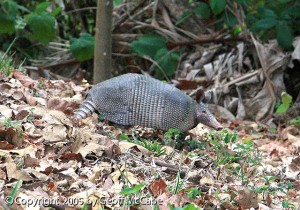- Home
- Accommodation
- Activities
- Area Info
- Maps
- Photo Galleries
- Real Estate
- Travel
Armadillo
Diet: The nine-banded armadillo mostly eats insects and larvae, often millipedes, beetles, ants, termites, and centipedes; it also lives on fruits, berries, fungi, snails, slugs, earthworms, and small vertebrates.
Height/Weight: An adult usually has a head and body length of 38.4 to 57.3 cm, and a tail length of 27.6 to 43 cm. They can weigh between 2.9 and 8 kg.
Where to Find it: The armadillo species can survive in many different types of habitat – cloud forest, lowland tropical rainforest, dry deciduous forest, as well as thorn scrub forest and grassland.
Life Span: Four years
 The armor of the armadillo has nine bands on the midsection of its back, hence it’s derived its name. This armor is made up of dermal bone plates covered with epidermal scales. The long slim tail is also coated with this armor. The armadillo also possess fine hair and plates on the back, and lots of hair growth on the belly. They can be spotted in and around the rainforest jungles of Montezuma.
The armor of the armadillo has nine bands on the midsection of its back, hence it’s derived its name. This armor is made up of dermal bone plates covered with epidermal scales. The long slim tail is also coated with this armor. The armadillo also possess fine hair and plates on the back, and lots of hair growth on the belly. They can be spotted in and around the rainforest jungles of Montezuma.
The armadillo species have a gestation period ranging from 60 to 90 days. They always give birth to young ones at a time. All the fours originate from the same egg and they are identical quadruplets. These creatures acquire sexual maturity around the age of 3 to 12 months, depending on the species. They are solitary animals and are fiercely protective of their holes even within their species.
The three banded armadillos are well-known for escaping danger by curling up into a ball and shielding themselves with their bodily armor. When the nine-banded armadillo senses danger, it stays upright, sniffs the air and listens keenly to the origination of the sound. If fleeing is not the option, the armadillo throw its attacker off guard by suddenly leaping into the air and later then escaping. The armadillo is also a dexterous digger.
Though these animals are nearly blind, they have been blessed with an excellent sense of smell that helps them to hunt for food like insects and larvae under the foliage litter. The nine-banded armadillo is the most commonly found species in Costa Rica of the twenty armadillo species. They are generally between 20-42 inches in length and weigh between 4-8 kilos. The nine-banded armadillo gets its name from the nine bands running across its back. They have four toes on their front feet and five on the hind feet. They have the trademark armor of the armadillo family, which envelopes their sides, head, tail, back, and the outsides of their legs. Unlike most other armadillos, these cannot roll themselves into a lump for defense. Their defense mechanism is jumping up to 4 feet in the air when frightened.
The nine-banded armadillo has tiny teeth, so its diet is restricted to soft or small plants or prey. It forages solitarily, scratching in the liter and smelling through it with its long nose. With its sharp, long claws, the armadillo can effectively dig burrows for itself and its family. The female keeps her young ones long after giving birth.
The texture of the soil in the region they inhabit plays a critical role in armadillo habitat. The more easily the soil is dug, the more these creatures are lured to the land. They also thrive in habitats which are verdant in water where climatic conditions are dry to mildly humid. The nine-banded armadillos are extremely active diggers, so much that a single member can dig several burrows which later provide shelter to other species in the region.
In Costa Rica, these creatures are spotted at the Santa Rosa National Park, La Selva, Corcovado National Park, Monteverde Cloud Forest Reserve; and could be found in San Vito and San Jose.
Further Reading and Information
Great Stuff

Clandestina Restaurant
My new favorite restaurant, Clandestina is not to be missed by food lovers staying anywhere near to Montezuma. Established in March 2015, Clandestina is the new kid on the block. The Oregon/Tico collaboration is a winner among locals and travelers alike, with artisan craft beers, made onsite by Butterfly Brewing Co. and delicious, exciting […]











